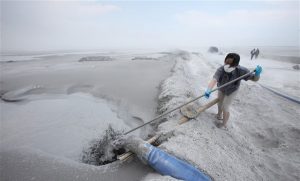Mass environmental protests in China have increased at a rate of around 29% per year since 1996, and by a staggering 120% in 2012. A common complaint is that the legal requirements for transparency and public participation in environmental decision-making are often ignored. It has been 10 years since the adoption of the Environmental Impact Assessment (EIA) Law, and seven years since the Ministry of Environmental Protection issued its implementing regulations, but many in China still feel the process is opaque.
The history of how public participation developed in the US may offer some insights for China. Some of the first experiments with it occurred during President Roosevelt’s New Deal in the 1920s and serve as a cautionary tale for allowing participation without clear rules or procedures.
The US began to address some of these issues with the Administrative Procedure Act in 1946, which set the foundations for future participation in environmental decision-making. By the 1960s US citizens were beginning to question the wisdom of blindly pursuing rapid development without first considering the potential environmental and public health consequences (much like in China today). By 1969 the United States had adopted the National Environmental Policy Act (NEPA), which was closely followed by groundbreaking laws such as the Clean Air Act (CAA) and the Clean Water Act (CWA).
The public participation requirements of China’s EIA Law, enacted in 2003, have many similarities with these laws. Both laws, as well as the CAA and CWA, require public notice of environmental reviews, disclosure of environmental review documents, public comment periods, the potential for hearings or meetings to garner public opinion, and substantive responses to comments received, including an explanation of why comments were or were not incorporated into the final review document.
Nevertheless, significant differences remain. NEPA requires the government agency to begin soliciting public opinion on a project at a much earlier stage than required by the EIA Law. This allows significant issues to be brought to light early on in the process and prevent later disputes. Moreover, the public comment period required by the EIA Law is a mere 10 days; NEPA requires a minimum of 45 days to comment on a draft Environmental Impact Statement.
With respect to document disclosure, the EIA Law and implementing regulations are vague at best – many environmental advocates continue to experience an uphill battle in obtaining the documents they need to meaningfully review the proposals under consideration. NEPA, on the other hand, specifically mandates the notice of public availability of environmental review documents, including any supporting documents used in the review process.
However, one of the most important differences between these laws is in obtaining a remedy in instances where the responsible entity fails to abide by the requirements for public participation. The EIA Regulations do allow citizens to petition the environmental agency charged with approving the final EIA if they feel that their concerns have not been addressed, but it is unclear what, if anything, the agency is required to do at that point.
In contrast, the CAA clearly requires the US Environmental Protection Agency (EPA) to revoke permits when petitioning citizens demonstrate that they were issued in violation of the law. For example, in a case I was involved in back in 2009, we discovered that a state agency had issued an air permit to a waste incinerator in Newark, in the state of New Jersey, without following any of the participation requirements. This incinerator was known for its out-of-date pollutant emissions controls, and the community wanted to advocate for technology that would protect their neighbourhood. We petitioned the EPA, which required the state agency to re-issue the permit to allow for public participation. The community was then able, through both written comments and public hearings, to convince the state agency to reach a deal with the facility to install technology for the control of fine particulate matter emissions.
Improving the EIA Process
While the situation may seem grim for Chinese citizens shut out of the public participation process, there are several reasons to hope for improvement. First, the MEP has been taking aggressive measures to discourage EIA consultants from falsifying public participation reports, even going so far as to withdraw their licenses. Nevertheless, some question whether such measures will be sufficient to address the systemic shortcomings of China’s EIA process.
Second, in May it was reported that amendments to the Administrative Litigation Law that may allow NGOs to file lawsuits against environmental agencies for failure to properly implement the EIA law will be presented to the Standing Committee of the National People’s Congress this month for review. If adopted, the amendments will presumably enable environmental NGOs to seek relief from the courts when the public’s right to participate is violated.
Finally, many key figures in the environmental movement in China are continuing to push for more equitable and inclusive environmental decision-making. For example, on August 23 over 20 prominent environmental lawyers, scholars and advocates gathered in Beijing for a symposium to discuss and address these issues. The participants all agreed that China’s EIA process is severely flawed and must be fixed – otherwise, China will continue to see a rapid rise in environmental protests around the country.





![Up to one million Amur falcons are concentrated in Nagaland on their migration route to southern Africa. Doyang reservoir, Nagaland [image by: BIOSPHOTO / Alamy Stock Photo]](https://dialogue.earth/content/uploads/2013/11/JR2TMB-300x200.jpg)